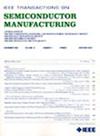Stress-Related Local Layout Effects in FinFET Technology and Device Design Sensitivity
IF 2.3
3区 工程技术
Q2 ENGINEERING, ELECTRICAL & ELECTRONIC
引用次数: 0
Abstract
Transistor characteristics in advanced technology nodes are strongly impacted by devices design and process integration choices. Variation in the layout and pattern configuration in close proximity to the device often causes undesirable sensitivities known as Local Layout Effects (LLEs). One of the sensitivities is related to carrier mobility dependence on mechanical stress, modulated by device design and local/ global environment. In this paper we investigate the impact of stress, developed during FinFET device fabrication, on electrical characteristics of transistors manufactured in 7nm silicon FinFET technology. Two sources of stress modulation are studied: (i) active region isolation (Diffusion Break) (ii) Metal Gate extension outside of the fins of the transistor. A 3D TCAD process model of a FinFET device was created and calibrated using electrical characteristics measured on foundry fabricated silicon wafers. The model was then applied to simulate mechanical stress in transistors with various design attributes for Diffusion Breaks (Single vs. Double Diffusion Break) and Gate Cuts, following by modeling of electrical characteristics. Very good agreement between simulations and measured silicon data has been obtained for PMOS and NMOS FinFET transistors. This work demonstrates that the layout sensitivity in discussed design cases can be explained by modulation of the mechanical stress and that the model can be used to predict successfully the stress distributions and their impact on electrical characteristics of FinFET devices. It can be applied to assist designers and technologists with Design-Technology Co-optimization, design rule and PDK development, and process optimization for best performance and reduced variability.应力相关的局部布局效应在FinFET技术和器件设计灵敏度
先进技术节点的晶体管特性受到器件设计和工艺集成选择的强烈影响。在靠近器件的布局和模式配置的变化通常会引起不希望的灵敏度,称为局部布局效应(LLEs)。其中一个敏感性与载流子迁移率依赖于机械应力有关,由器件设计和局部/全局环境调节。在本文中,我们研究了在FinFET器件制造过程中产生的应力对7nm硅FinFET技术制造的晶体管电特性的影响。研究了应力调制的两个来源:(i)有源区隔离(扩散中断)(ii)晶体管翅片外的金属栅极延伸。建立了FinFET器件的三维TCAD工艺模型,并利用在晶圆上测量的电特性对其进行了校准。然后将该模型应用于模拟具有不同设计属性的扩散断开(单扩散断开与双扩散断开)和栅极切断的晶体管中的机械应力,然后对电特性进行建模。对于PMOS和NMOS FinFET晶体管,仿真结果与实测数据非常吻合。这项工作表明,在讨论的设计案例中,布局灵敏度可以通过机械应力的调制来解释,并且该模型可以成功地用于预测应力分布及其对FinFET器件电特性的影响。它可以帮助设计师和技术人员进行设计-技术协同优化,设计规则和PDK开发,以及最佳性能和减少可变性的过程优化。
本文章由计算机程序翻译,如有差异,请以英文原文为准。
求助全文
约1分钟内获得全文
求助全文
来源期刊

IEEE Transactions on Semiconductor Manufacturing
工程技术-工程:电子与电气
CiteScore
5.20
自引率
11.10%
发文量
101
审稿时长
3.3 months
期刊介绍:
The IEEE Transactions on Semiconductor Manufacturing addresses the challenging problems of manufacturing complex microelectronic components, especially very large scale integrated circuits (VLSI). Manufacturing these products requires precision micropatterning, precise control of materials properties, ultraclean work environments, and complex interactions of chemical, physical, electrical and mechanical processes.
 求助内容:
求助内容: 应助结果提醒方式:
应助结果提醒方式:


